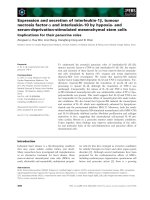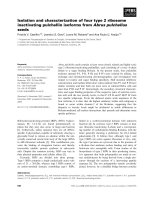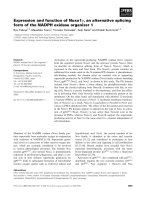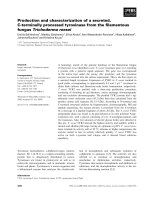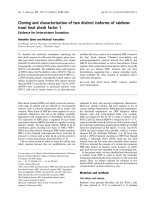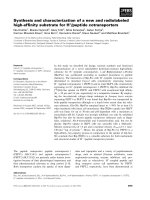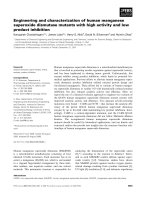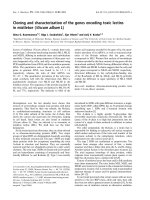Báo cáo khoa học: Expression and characterization of the protein Rv1399c from Mycobacterium tuberculosis A novel carboxyl esterase structurally related to the HSL family docx
Bạn đang xem bản rút gọn của tài liệu. Xem và tải ngay bản đầy đủ của tài liệu tại đây (536.85 KB, 9 trang )
Expression and characterization of the protein Rv1399c
from
Mycobacterium tuberculosis
A novel carboxyl esterase structurally related to the HSL family
Ste
´
phane Canaan
1
, Damien Maurin
1
, Henri Chahinian
2
,Be
´
ne
´
dicte Pouilly
1
,Ce
´
cile Durousseau
1
,
Fre
´
de
´
ric Frassinetti
1
,Lore
´
na Scappuccini-Calvo
1
, Christian Cambillau
1
and Yves Bourne
1
1
Architecture et Fonction des Macromole
´
cules Biologiques, AFMB UMR 6098, CNRS, Marseille, France;
2
Laboratoire
d’Enzymologie Interfaciale et de Physiologie de la Lipolyse, CNRS UPR 9025, Marseille, France
The Mycobacterium tuberculosis genome contains an
unusually high number of proteins involved in the metabo-
lism of lipids belonging t o the Lip family, includ ing various
nonlipolytic and lipolytic hydrolases. Driven by a structural
genomic approach, w e have bio chemically characterized t he
Rv1399c gene product, LipH, previously annotated as a
putative lipase. Rv1399c was overexpressed in E. coli as
inclusion bodies and r efolded. Rv1399c efficiently hydro-
lyzes soluble triacylglycerols and vinyl esters. It is inactive
against emulsified substrate and its catalytic activity is
strongly inhibited by the diethyl p aranitrophenyl phosphate
(E600). These kinetic behaviors unambiguously classify
Rv1399c as a nonlipolytic rather than a lipolytic hydrolase.
Sequence alignment reveals that this enzyme b elongs to the
a/b hydrolase fold family and shares 30–40% amino acid
sequence identity w ith members of the hormone-sensitive
lipase subfamily. A model of Rv1399c derived from
homologous three-dimensional structures reveals a canon-
ical catalytic triad (Ser162, His290 and Asp260) located at
the bottom o f a solvent accessible pocket lined by neutral or
charged residues. Based on this m odel, kinetic data o f the
Arg213Ala mutant partially explain the role of the guanid-
inium moiety, located close to His290, to confer an unusual
low pH s hift of the catalytic histidine in the wild type
enzyme. Overall, these data identify Rv1399c as a new
nonlipolytic hydrolase from M. t uberc ulosis and we thus
propose to reannotate its gene product as NLH-H.
Keywords: e sterase; nonlipolytic hydrolase; Rv1399c; tuber-
culosis.
The recent elucidation of the complete sequence of Myco-
bacterium tuberculosis genome [1] has offered new perspec-
tives for the search of novel drugs against tuberculosis. The
disease was responsible for around 2.5–3 million deaths in
2002 and t he World Health Organization (WHO) estimates
8 million new tuberculosis patients each year [2]. The
current genome annotation consists of 4000 predicted
proteins, classified into 11 distinct protein groups [3], of
which 48% have unknown function. Comparative sequence
analysis of the M. tuberculosis genome has revealed that it
contains 250 enzymes involved in lipid metabolism com-
pared to only 50 in Escherichia coli. Among these enzymes,
a family of 21 carboxyl este r h ydrolases, called Lip (A to W,
except K and S), have been annotated as putative esterases
or lipases, based on the presence of the consensus sequence
GXSXG characteristic of members of the a/b hydrolase
fold family. Within this family, the recent crystal structure
of the M. tuberculosis antigen 85C (Ag85C) [4], a mycolyl-
transferase required for survival of mycobacteria, along
with that of the noncatalytic M. t uberculo sis MPT51
protein ( FbpC1) [5], which is involved i n mycobacteria
pathogenicity, have revealed that they share the same a/b
hydrolase fold. Therefore, a detailed biochemical charac-
terization of all members of the Lip family should be
performed beyond the computational analysis. For many
years, it was generally assumed that lipases are poorly active
against soluble esters a nd become mark edly active when the
solubility limit of the substrate is exceeded, a phenomenon
called interfacial activation [6]. In contrast, esterases do not
share this behavior and exhibit their maximal activity on
esters in solution. Unfortunately, biochemical studies of
several lipases have showed that the interfacial activation
phenomenon cannot be considered a general (and sufficient)
rule to discriminate between a lipase and esterase [7–9]. A
clear d istinction between lipases and este rases was estab-
lished recently from the comparison of the K
1/2
values of
these two classes o f carboxyl ester hydrolas es using p artially
soluble triacylglycerols and vinyl esters as substrates [7].
Where a lipase can also be considered an esterase, the K
1/2
values represent a reliable criterion to discriminate between
these two classes of enzymes. Consequently, we propose to
rename lipases as lipolytic hydrolases (LH) while the
remaining members of th e family denote nonlipolytic hydro-
lases (NLH). Therefore, without a detailed biochemical
Correspondence to S. Canaan, A rchitecture et F onction des Macro-
mole
´
cules Biologiques, AFMB UMR 6098, CNR S, 3 1 C hemin J oseph
Aiguier, 13402 Marseille Cedex 20, France. Fax: +33 491 16 45 36,
Tel.: +33 491 16 45 12, E-mail:
Abbreviations : HSL, h ormone-sensitive lipase; NLH, nonlipolytic
hydrolase; LH, lipolyt ic hydrolase; IB, inclusion bodies; IPTG, iso-
propyl thio-b-
D
-galactoside; CMC, c ritical m icellar c oncentration;
E600, diethyl para-nitrophenyl phosphate; D LS , dynamic light
scattering.
(Received 7 June 2004, accepted 17 August 2004)
Eur. J. Biochem. 271, 3953–3961 (2004) Ó FEBS 2004 doi:10.1111/j.1432-1033.2004.04335.x
characterization, the Lip term could be c onfused to refer to
a NLH, and the original accession number should b e used
to avoid confusion.
Here we report the cloning, expression and refolding of
the M. tuberculosis Rv1399c gene product, a member o f the
Lip family. The biochemical characterization of Rv1399c,
using triacylglycerols and vinyl esters as substrates, demon-
strates that this carboxyl ester hydrolase must be classified
as an NLH instead of an LH as proposed initially by
bioinformatic tools [1,3]. Rv1399c efficiently hydrolyzes
short-chain t riacylglycerols and vinyl esters and has no
detectable activity against emulsified substrates. We thus
propose to rename Rv1399c NLH-H instead of LipH.
Sequence alignment has revealed that this enzyme defines a
new NLH that is structurally related to the hormone-
sensitive lipase (HSL) family and a model derived from a
subset of homologous 3D structures reveals the architecture
and functionalities of the Rv1399c active site, consistent
with our experimental data. Based on this model, the kinetic
behavior of the Arg213Ala mutant partially explains the
unusual acidic pKa shift observed f or the catalytic His290
residue in the wild-type (wt)enzyme.
Experimental procedures
Materials
The Pfx DNA polymerase, pDonor 201, pET-Dest42 and
pDest17 plasmid vectors were purchased from Invitrogen.
BL21(DE3)pLysS E. coli cells were purchased from Nov-
agen. N i
+
-agarose gel was obtained from Amersham
Biosciences. Vinyl acetate, vinyl propionate, vinyl butyrate,
triacetin, t ributyrin and the diethyl para-nitrophenyl phos-
phate (E600) were obtained from Sigma–Aldrich–Fluka.
Tripropionin was purchased from Acros Organics (Geel,
Belgium).
Methods
Cloning. The cDNA fragment of the Rv1399c ORF was
amplified by PCR from the MTCY21B4.16c cosmid
provided by the Pasteur Institut [1,10]. The primers,
containing, at their 5¢-and3¢-ends, the respective attB1
and attB2 recombination sites were: 5¢-taacagagccg
accgtcgcccgg-3¢ (forward primer) and 5¢-cttatgcgtgcaa
cgccctctt-3¢ (reverse primer). The PCR product was purified
from agarose gel and was inserted into t he expression vector
following the manufacturer’s instruction (Gateway, Invi-
trogen). The correct insertion of the Rv1399c ORF was
confirmed by DNA sequencing.
In our hands, protein expression using the commercially
available pDest 17 plasmid frequently appeared to be
constitutive and occurred whether or not the isopropyl t hio-
b-
D
-galactoside (IPTG) inducer was added to the medium.
This problem, which was unsolved using the BL21(DE3)-
pLysS cells known to over-express lysozyme as a compet-
itive inhibitor of the T7 RNA polymerase, was most
probably due to the absence of the lac operator dowstream
of the T7 p romoter. To overcome this problem, a derivative
of the pDest 17 plasmid, pD est 1 7O/I, was constructed from
the pET-Dest42 plasmid and contains a P shAI-XbaI-
digested fragment that encompassed the Lac I gene (under
the control of a constitutive promoter) upstream the T7
promoter followed by Lac O (the DNA binding site of Lac
I). The resulting construct constitutively expresses Lac I,
which inhibits the T7 RNA polymerase in b inding to its
specific DNA binding site on Lac O.
Mutagenesis. Site-directed mutagenegis, which was per-
formed using the QuickchangeÒ site-directed mutagenesis
system (Stratagen, La Jolla, CA, USA), was used for the
mutation of Arg213 fi Ala. The oligonucleotides u sed
were: 5¢-gcgccaatcctggacgctgacgtcatcgacgcg-3¢ (forward)
and 5¢-cgcgtcgatgacgtcagcgtccaggattggcgc-3¢ (reverse). The
bases in bold indicate the location of the mutation. DNA
sequence of the mutant was confirmed by DNA sequencing
(Millegen, Prologue Biotech, France).
Protein expression. BL21(DE3)pLysS cells were trans-
formed with the expression construct pDest 17O/I harbor-
ing the Rv1399c coding region. Cells were grown at 37 °C
in LB medium containing 100 lgÆmL
)1
ampicillin and
34 lgÆmL
)1
chloramphenicol until a D
600
value between 0.6
and 0.8 was reached. Protein expression w as induced by
adding 2 m
M
IPTG for 4 h at 37 °Candthen16hat15°C.
Rv1399c was highly overexpressed but found exclusively in
inclusion bodies.
Purification of inclusion bodies. Cells were harvested at
4 °C by centrifugation at 9000 g for 15 min. The pellet was
resuspended in ice-cold lysis buffer [50 m
M
Tris/HCl,
pH 8.0, 150 m
M
NaCl, 10 m
M
imidazole, 1 m
M
EDTA,
0.1% (v/v) Triton X-100, 0.25 mgÆmL
)1
of lysozyme and
1m
M
phenylmethanesulfonyl fluoride] and stored at
)80 °C overnight. T he pellet was thawed on ice for 1 h
andthen10lgÆmL
)1
DNase a nd 20 m
M
MgSO
4
(final
concentration) were added to the cell s uspension f or 30 min.
Cells were disrupted by ultrasonication (10· with a 15 s
cycle) using a Branson Sonifier 450. Inclusion bodies were
separated from t he cell e xtract by centrifugation at 17 000 g
for 30 m in. The pellet was then washed with 10 m
M
Tris/
HCl, pH 8.0 and 150 m
M
NaCl, sonicated (4· with a 15 s
cycle) and collected by centrifugation at 17 000 g for
20 min, this procedure was repeated three times. Inclusion
bodies were solubilized by stirring at 4 °C overnight in a
40 mL solution containing 10 m
M
Tris/HCl, pH 8.0,
150 m
M
NaCl and 6
M
guanidine hydrochloride. The
solubilized protein was clarified from insoluble material at
4 °C by centrifugation at 17 000 g for 15 min The super-
natant was l oaded (3 mLÆmin
)1
) onto a Ni
+
-agarose
column (1 mL resin for 5 mg of recombinant protein)
previously equilibrated with buffer A (10 m
M
Tris/HCl,
pH 8.0, 150 m
M
NaCl, 1 0 m
M
imidazole and 8
M
urea).
The column was then washed using five column volumes of
5% and 10% of buffer B (buffer A + 500 m
M
imidazole).
Enzyme was eluted with 50% of buffer B; f ractions of eluted
peaks containing purified Rv1399c were analyzed by SDS/
PAGE [11], pooled and concentrated up to 4–5 mg ÆmL
)1
using an Amicon cell.
Refolding. Purified Rv1399c was refolded by a dilution
method consisting of diluting the concentrated protein in
buffers with different pH and various compositions. The
refolding c onditions were determined by a refolding method
3954 S. Canaan et al. (Eur. J. Biochem. 271) Ó FEBS 2004
based on the measurement of the turbidity at 340 nm using
a 96-well plate [12]. The final refolding conditions consisted
of dilut ing Rv1 399c 20· in 50 m
M
Trisbuffer,pH 7,at4 °C
for 2 days. Rv1399c was concentrated up to 2–3 mgÆmL
)1
and traces of urea and imidazole were removed using a
desalting column ( HiPrep
TM
26/10, Amersham Bioscienc es).
Rv1399c was then concentrated up to 3 mgÆmL
)1
and
stored overnight at )20 °C, and after thawing, the ÔactiveÕ
refolded material was recovered by centrifugation at
17 000 g for 15 min. Rv1399c is stable in the refolding
buffer for at least 1 month at 4 °Candcanbestoredat
)20 °C for several months. Protein concentration was deter-
mined by measuring at A
280
using e
280
¼ 1.399 mg
)1
Æ
mLÆcm
)1
. Electrospray mass spectrometry was performed
using a Voyager-DE RP spectrometer (PerSecptive, Biosys-
tems) and mass analysis of trypsin-digested peptides
confirmed the expected calculated molecular mass of
36 313 Da. Samples (0.7 lL containing 15 pmoles) were
mixed with an equal volume of sinapinic acid matrix
solution and spotted on the target, then dried at room
temperature for 10 min.
Circular dichoism and dynamic light scattering. The
presence of secondary structural elements in refolded
Rv1399c was assessed by CD using a Jasco PTC-423S
apparatus and analyzed with the program
CDNN
(
CD SPEC-
TRA DECONVOLUTION
, version 2.1). Rv1399c (0.2 mgÆmL
)1
)
spectra we re recorded at 20 °C between 185 and 260 nm in
10 m
M
Tris/HCl, pH 7.0, with a 30 s averaging step. The
final CD spectrum was obtained from the average of three
passes.
The aggregation level of purified Rv1399c was estimated
by dynamic light scattering (DLS) analysis following the
manufacturer’s instructions. Experiments were performed
at 20 °C with filtered (Millex syringe filters, 0.22 lm;
Millipore Corp.) p rotein samples (12 lLat3mgÆmL
)1
)
using a Dynapro MSTC-200 (Protein Solutions). All
calculations were performed using the software provided
by the manufacturer.
Kinetic assays. Enzymatic hydrolysis of solutions and
emulsions of various esters was followed potentiometrically
at 2 5 °C using a pH-stat (TTT 80, Radiometer, Copenha-
gen, Denmark) for at least 5 min. Assays were performed in
30 mL of 2.5 m
M
of Tris/HCl buffer, pH 7.0 and 0.1
M
NaCl. Release of fatty acid was titrated with 0.1
M
NaOH.
Enzymatic activity was expressed in units (U) per mg of
protein where 1 U corresponds to the liberation of 1 lmol
acidÆmin
)1
under standard conditions [13]. Assays using
olive oil and vinyl laurate were performed at pH 8.5 due to
the high pKa values of the oleic and l auric acids (8.1 and 7.4,
respectively).
pH stability – pH and temperature dependence activ-
ity. Tripropionin was chosen as substrate to perform the
pH and temperature dependence experiments rather than
more volatile vinyl esters. The pH stability profile
of Rv1399c was obtained after enzyme incubation for
1 h using 100 lL of buffers at different pH values
containing, 150 m
M
NaCl and: 150 m
M
sodium acetate,
pH 4 .0; 150 m
M
sodium acetate, pH 5.0; 150 m
M
Mes,
pH 6.0; 150 m
M
Tris/HCl, pH 7.0; 150 m
M
Tris/HCl,
pH 8.0 and 150 m
M
glycine, pH 9.0. The residual activity
was determined potentiometrically at 25 °C at p H 7.0 using
tripropionin at the concentration of 9.3 m
M
as substrate as
above described. For the determination of the temperature
dependence profile, buffer and substrate were pre-equili-
brated and the background was recorded for 5 min without
the enzyme. The histidine titration cu rve was performed
using vinyl butyrate (20.7 m
M
) as a substrate. The pH value
was adjusted and the enzyme (7.4 lg) was added in the
vessel. Activity assays at acidic pH were corrected using the
calculated pKa value of 4.87 for butyric acid.
Inhibitor assay. Purified Rv1399c (2.51 nmol) was pre-
incubated at 25 °C with different E600 inhibitor/enzyme
molar ratio (2 and 10) in a final v olume of 32 lL. The
remaining activity was measured potentiometrically as a
function of time using tripropionin as above described.
Model building. The Rv1399c model was generated from
the automatic protein structure homology-modeling server
using
SWISS
-
MODEL
software (Biozentrum) [14–16], and
validated by the
PROCHECK
program [17]. Sequence align-
ment was performed initially using t he multiple sequence
alignment s oftware
T
-
COFFEE
[18], d isplayed wi th
ESPRIT
[19]
and then manually adjusted. The E600 inhibitor, which was
taken from the crystal structure of the cutinase–E600
complex [20], was positioned into the active site of Rv1399c
based on superimposed Ca atoms. Figure 4 was drawn with
SPOCK
[21] using the coordinates of Ag85C [4], cutinase
[20,22] and Bacillus subtilis lipase A [23].
Results and Discussion
Cloning and expression of Rv1399c
The Rv1399c gene product encodes a 318 amino acid
protein with a molecular mass of 31.7 kDa and a
calculated pI of 4.53 and belongs to the Lip family that
consists of 21 members in M. tuberculosis.Attemptsto
express Rv1399c as a soluble protein using different E. coli
bacterial strains, different temperatures, media and fusion
protein constructs were unsuccessful. In all cases, the
recombinant protein was expressed as inclusion bodies with
the highest expression level obtained from the pDest 17O/I
construct using the BL21 (DE3)pLysS cells grew in LB
medium after 4 h of IPTG induction (Fig. 1).
Purification and refolding of Rv1399c
Given the large quantity of insoluble material obtained [up
to 160 mg of protein from 6 L of cell culture (Table 1,
Fig. 1 lane 4 )], we looked for optimal conditions to
solubilize Rv1399c using a new r efolding analytical
approach by sample dilution consisting of a rapid screening
of different buffers in 96-well microtiter plates coupled to
spectrophotometric analyses [12]. Among the 96 refolding
conditions tested, 1 4 of t hem y ielded soluble Rv1399c based
on the turbidity measurement at 340 nm. The choice of the
final refolding buffer was guided by the optimum refolding
yield. Rv1399c was refolded at 4 °Cover48husingthe
buffer composition identified in the analytical s tep (50 m
M
Tris/HCl, pH 7.0).
Ó FEBS 2004 Biochemical characterization of Rv1399c from M. tuberculosis (Eur. J. Biochem. 271) 3955
The annotation of Rv1399c as a putative LH prompted
us to find a s uitable substrate, such a s t riglycerides and vinyl
esters, known to be s electively hydrolyzed by a l arge number
of NLH as well as LH. The preliminary biochemical
experiments allowed us to follow the specific activity of
Rv1399c along the refolding process a nd to estimate the
refolding y ield (Table 1). Using tripropionin as a substrate,
a specific activity of 80 UÆmg
)1
was obtain ed a fter the
dilution step and increased 6· after two days. After the
concentration s tep ( 2–3 mgÆmL
)1
), the specific activity
increased to 995 UÆmg
)1
, suggesting that some insoluble
material was s till refolded during t his process. The last
freezing/thawing step appeared to be an efficient and
powerful purification procedure. Indeed, whereas the total
activity was not affected significantly, the specific activity
increased from 1050 to 1350 UÆmg
)1
. This was due to the
presence of precipitated material accounting for 13% of the
total protein and arising from unfolded or misfolded
Rv1399c that could be easily eliminated by centrifugation.
Finally, 80 mg of purified active Rv1399c, out of 160 mg
present in inclusion bodies, were recovered after the
Ni
+
-column purification step, resulting in a refolding yield
of 50% with a purity of 98% based on SDS/PAGE gel
(Fig. 1, lane 6). Moreover, DLS analysis indicates that
Rv1399c behaves as a monodisperse in solution with an
estimated hydrodynamic radius consistent with its molecu-
lar size for a monomeric protein (data not shown).
Biochemical characterizations of Rv1399c
Catalytic properties. The specific activity determined
against vinyl esters and triacylglycerols clearly shows that
Rv1399c specifically hydrolyzes short- chain esters (Table 2).
In all cases, the shape of the Michaelis–Menten represen-
tation curves [V ¼ f([S]); V is the velocity (U) and [S] is the
substrate concentration (m
M
)] is hyperbolic and the max-
imal activity was measured in the soluble concentration
range of the selected esters. Indeed, the K
1/2
value of
Rv1399c using v inyl acetate (8 m
M
) is similar to those
determined for pig liver esterase and acetylcholinesterase
(4 m
M
). Similarly, the K
1/2
value of Rv1399c (2.76 m
M
)
using soluble t riacetin at a concentration far b elow its CMC
(105 m
M
) [24] is similar to that of pig liver esterase (4 m
M
)
but is lower to that of acetylcholinesterase (30 m
M
). The
kinetic behavior of Rv1399c using short-chain soluble vinyl
esters and triacylglycerols along with the lack of d etectable
activity using insoluble vinyl esters (vinyl laurate) or
triacylglycerols (trioctanoin, olive oil) unambiguously clas-
sify Rv1399c as a NLH rather than a LH. However,
Rv1399c is able to hydrolyze a wide range of ester bonds
and does not show a substrate specificity towards the
alcohol or the acid moiety of short-chain esters (Table 2).
The pH (Fig. 2A) and temperature (Fig. 2B) stability
profiles of Rv1399c have been also investigated. The choice
of tripropionin (9.3 m
M
) as sub strate was g uided by t he high
stability of this compound in the w ide range of temperature
used. Our data indicate that Rv1399c is very sensitive to t he
pH as no activity was recorded after 1 h incubation in
acetate buffer (pH 4.0). The enzymatic activity of Rv1399c
increases up to 4· at 45 °C and then dropped rapidly at
higher temperatures with no detectable activity above
60 °C, indicating that Rv1399c cannot be considered as a
thermophilic NLH.
The catalytic triad
From a kinetic point of view, we have established that
Rv1399c is a NLH, consistent with the sequence homology
detected between Rv1399c and other serine carboxyl ester
Table 1. Flowsheet of the Rv1399c procedure purification and refolding. Tot al activity, 1 U ¼ 1 lmol of s ubstrate hydrolysed per min.
Steps
Protein
amount (mg)
Total
activity (U)
Amount of active
protein (mg)
Specific
activity (UÆmg
)1
) % of refolding
Inclusion bodies after washing 1040 – – – –
Ni ± chelating Sepharose and concentration 160 – – – –
Refolding by dilution (T0) 160 12880 9.5 80.5 5.9
Refolding by dilution (day two) 160 77760 57.6 486 35
Concentration and centrifugation 104 103480 76.7 995 48
Desalting column and concentration 92 92000 68.1 1000 42.6
After freezing 92 96600 71.5 1050 44.7
After thawing and centrifugation 80 108000 80 1350 50
1
116 kDa
66 kDa
45 kDa
35 kDa
25 kDa
234 5 6 7
Fig. 1. SDS/PAGE for expression and refolding of Rv1399c in E. coli.
Protein samples were lo aded on a 14% S DS/PAGE under reducing
and Coomassie-blue staining conditions. Lanes 1 and 7, molecular
mass markers (Fermentas); lane 2, E. coli proteins ( 30 lg) before
IPTG induction; lane 3, E. coli proteins ( 35 lg) after IPTG in duc-
tion; lane 4, purified Rv1399c (14.5 lg) eluted from the Ni-nitrilotri-
acetic acid column; lane 5, partially refolded Rv1 399c ( 6.8 lg); lane 6,
refolded Rv1399c after the freeze/thaw step (11 lg). The apparent
molecular mass of 36313 Da as estimated by Electrospray mass
spectrometry is due to the p resence, at the N-terminus, o f t he His
6
-tag
and the additional 21 residues from the expression plasmid.
3956 S. Canaan et al. (Eur. J. Biochem. 271) Ó FEBS 2004
hydrolases (Fig. 3). These enzymes share a functional
catalytic triad made of a catalytic nucleophile serine,
associated to a proton c arrier histidine and a c harge r elaying
aspartic (or glutamic) acid. To further investigate the
biochemical characterization of the enzyme, we have
titrated these key residues that form the catalytic triad of
Rv1399c.
Catalytic serine. Diethyl p aranitrophenyl phosphate
(E600), a specific powerful inhibitor of s erine hydrolases
was assayed on Rv1399c. As shown in Fig. 2D, the purified
enzyme was incubated with different ratio of E600. In each
case, the kinetics of inactivation of Rv1399c have been
monitored b y measuring the remaining activity, a s a
function of time, using tripropionin as a substrate.
Table 2. Comparison of the maximum specific activities of Rv1399c, acetylcholinesterase and pig liver esterase recorded using vinyl esters and
triacylglycerols as substrates. All specific activities are in lmol o f acid released per min and per mg of enzyme in 2.5 m
M
Tris buffer pH 7.0
containing 100 m
M
NaCl at 25 °C. Substrate con centrations (indicatedinparentheses)areexpressedinm
M
; ND, non determine d. Acetylcholine-
sterase and pig liver esterase values are taken from Table 1 of referenc e [7].
Enzyme
Substrate (concentration)
Vinyl
acetate
(315)
Vinyl
propionate
(80)
Vinyl
butyrate
(20)
Vinyl
laurate
–
Triacetine
(300)
Tripropionin
(9.28)
Tributyrin
(9.1)
Trioctanoin
–
Olive
oil
–
Acetylcholine
(33)
Rv1399c 610 1618 1123 0 184 1350 456 0 0 0
Acetylcholinesterase 970 210 0 0 450 0 0 0 0 1420
Pig liver esterase 320 300 470 0 60 50 70 0 0 ND
100
AB
CD
80
60
40
20
0
100
80
60
40
20
0
100
80
60
40
20
0
43 567
7
6
5
4
3
2
1
0
8910
pH
432 56789
p
H
Residual activity (%)
Residual activity (%) Activity (unit)
Activity (%)
0 10203040506070
Temperature (C)
WT
Mutant
Time (min)
0.5 15
43
1 for 10
1 for 2
pKaWT
pKaMut
Fig. 2. Kinetic assays of Rv1399c. (A) pH stability, (B) temperature dependence. (C) Titration curves of wt Rv1399c (s) and the Arg213Ala mutant
(h) catalytic histidine residue. The curve profiles corresponding to pH values below 3.75 have been extrapolated due to Rv1399c instability at acidic
pH. (D) Rv1399c inhibitory effect using the E600 inhibitor as function of time. The protein/inhibitor ratio is indicated. Enzyme a ctivity was
determined as described in the Methods section.
Ó FEBS 2004 Biochemical characterization of Rv1399c from M. tuberculosis (Eur. J. Biochem. 271) 3957
Rv1399c is strongly inhibited by E 600 with a K
I
value in the
7to30· 10
)10
M
range, suggesting that the catalytic serine
is highly reactive. Moreover, the inhibition by the E600 is
not influenced by the presence of detergent, in contrast to
lid-containing human gastric and pancreatic lipases, sug-
gesting that the catalytic s erine o f R v1399c is fully accessible
to the solvent.
Catalytic histidine. It is widely assumed that serine
carboxyl ester hydrolases, like serine proteases, require an
appropriate protonation state of essential catalytic residues
in the active p H range. The imidazole ring of the catalytic
His must be in a neutral state to capture the hydrogen of the
catalytic serine for an efficient nucleophilic attack of the
substrate ester bond by the serine alcoholate. The shape of
the titration curve of the catalytic histidine shows an
apparent pKa value of the essential histidine estimated to
4.1 (Fig. 2C). This acidic pKa shift of the histidine residue
has been described previously for carboxypeptidase Y [25]
and gastric lipases [26–28] but no clear explanation of such
an atypical property for t he enzyme function has b een yet
established.
3D Model of Rv1399c
Novel member of the HSL family. BLAS T searches
against t he 163 currently available microbial genomes reveal
that Rv1399c is only found in Mycobacteria species, e.g.
Mycobacterium bovis AF2122/97 and Mycobacterium t uber-
culosis CDC1551,withe-values in the 10
)150
range corres-
ponding to 91% and 53% identity, respectively. Moreover,
BLAST searches against the Protein Data Bank identified
four top-ranked hits with sequence identity ranging from
44% to 31%. These structural homologs, which are
members of the human HSL protein family, include the
thermophilic esterase from Bacillus acidocaldarius [29]
(44.2% of sequence identity), the thermophilic esterase
from Archaeoglobus fulgidus [30] (43%), the brefeldin A
esterase from B. subtilis [31] (33%) and the heroin esterase
from Rhodococcus sp. strain H1 [32] (31%) (Fig. 3). Two
invariant sequence motifs within members of the HSL
protein family, namely the active site residues Ser162 and
Asp260 and the consensus motif HGGG, are conserved in
Rv1399c. In addition, a significant sequence identity (22%)
can be found between Rv1399c and the catalytic domain of
the HSL, indicating that Rv1399c is likely a new member of
the HSL family [31], which to date, comprises more than 65
members.
A model of Rv1399c was built with the
SWISS MODEL
server using, as templates, the co ordinates of structural
homologues of the a/b hydrolase fold family [33] that
present the highest sequence homologies (see above) with
Rv1399c: serine hydrolase (accession code 1evq) [29], and
carboxylester hydrolase (1jji) [30]. This m odel reveals the
overall topological organization of Rv1399c, predicts the
location of the catalytic triad, provides a valuable template
for further structure-function studies and is consistent with
our biochemical data. As expected, Rv1399c consists of
three domains. The largest domain encompasses strands b1
to b6 a nd strand b7 to the C-terminus. The central b sheet is
composed of 7 parallel b strands associated to an anti-
parallel strand (b2) and is surrounded by 5 helices (a1, a2,
a3, a7anda8). T he second domain c onsists of helices a4, a5
and a6 a ll clustered on the top of t he enzyme, as described
by Wei et al. [31] (Fig. 4). The third domain, which consists
of the 50 first amino acids, could not been modeled. This
Fig. 3. Amino-acid sequence alignment
between Rv1399c and four non lipolytic hydro-
lases (NLH) of known 3D structure. The
alignment was performed using the
T
-
COFFEE
and
ESPRIT
programs (available from the
expasy web site). Conserved residues are
boxed and those similar are indicated with a
black background. Residues involved in the
catalytic triad are indicated by w, while
Arg213 (j) a long with the three hydr ophobic
residues Trp92, Phe219 and Trp222, involved
in the substrate s pecificity, are indicated by m.
3958 S. Canaan et al. (Eur. J. Biochem. 271) Ó FEBS 2004
α4
α5
α6
α7
α3
α8
β8
β7
β6
β5
β3
β4
β2
β1
α1
α2
Asp 260
His 290
Ser 162
Asp214 Asp214
Asp212
Asp212
Asp161
Asp161
Arg213
Arg213
Phe219
Phe219
Trp222 Trp222
Trp92
Trp92
Gly91
Gly91
Gly90
Gly90
Gly89
Gly89
Gly291
Gly291
T
y
r292 T
y
r292
Tyr190 Tyr190
Tyr190
Tyr190
His290
His290
His88
His88
Ser162
Ser162
Rv1399c Ag85c
Fusarium solani pisi cutinase Bacillus subtilis lipase A
A
B
C
Fig. 4. Model of Rv1399c. (A) Ribbon diagram of Rv1399c model. The central b-sheet and surrounding a-helices are shown in green and
red, respectively. Residues of the catalytic triad (Ser1 62, Asp260 and H is290) are shown in CPK and are colored in blue. (B) Close-up stereoview of
the active s ite poc ket w ith b ound E 600 i nhibito r (red ) sh owing re sidue s of the oxyanion h ole. Residu es th at co uld play a role in substrate recognition
are also indicated. (C) Molecular surface of Rv1399c model, Ag85C (1DQZ), Fusarium solani pisi cutinase (2CUT) and Bacillus subtilis lipase A
(1ISP), viewed i n a sim ilar o rientation and looking down the active site, with s urface p atche s made f rom a lipha tic o r h ydrophobic residu es (Val, Ala,
Leu, Ile, Trp, Tyr, Phe and Met) indicated in yellow. In all cases, the catalytic serine residue is shown in red.
Ó FEBS 2004 Biochemical characterization of Rv1399c from M. tuberculosis (Eur. J. Biochem. 271) 3959
model is in agreement with our CD data showing two
minima at 205 and 215 nm, indicating that Rv1399c is
composed of 22% o f a-helices, 25% of b-strand a nd 39% o f
random coil.
The catalytic triad is located at the bottom of a small
pocket, 20 A
˚
length and 10 A
˚
wide. The pocket is made by
three distinct surface regions: a 10-residue loop connecting
helix a8tostrandb8, a five-residues loop connecting strand
b3 to helix a1 and two small h elices (a4anda6).
The catalytic site consists of a functional catalytic triad
found in all serine enzymes of the a/b hydrolase fold family
in which Ser162 is the nucleophile residue, His290 is the
proton carrier and Asp260 is the charge relay network.
Ser162 is located within the Ônucleophilic elbowÕ connecting
strand b5 and helix a3, while His290 and Asp260 e merge
from the b8-a8andb7-a7 loops, respectively. Another
important feature of the catalytic machinery is the so-called
oxyanion hole necessary for the stabilization of the oxyan-
ion transition state [34]. In Rv1399c, the oxyanion hole is
likely to be formed by the amides of Ala163, Gly89 and
Gly90, the latter’s being found in the HGGG consensus
sequence motif characteristic of members of the HSL family
[35]. Our model shows that the architecture of the active site
could accommodate an E600 inhibitor molecule covalently
bound to the catalytic Ser162 without d rastic conforma-
tional changes (Fig. 4C).
The acyl binding pocket (Fig. 4C) is delimited at one end
by the three hydrophobic side chains Trp92, Phe219 and
Trp222 that could play the role of filter thus preventing
binding of substrate with an acyl chain larger than eight
carbon atoms. This feature could explain the absence of
Rv1399c activity against triacylglycerols or esters with
longer carbon chain (Table 2). Moreover, t he three charged
residues Asp212, Arg213, Asp161 located at the periphery
of the pocket could have a role in substrate recognition,
suggesting a preference for a polar noncationic substrate as
a natural substrate since Rv1399c does not exhibit any
catalytic activity against acetylcholine (Table 2).
A structural s imilarity search, performed with DALI
using the coordinates of t he Rv1399c model as a template
identified numerous homologous proteins from the a/b
hydrolase fold family ( Z score v alues >10), including
Ag85C from M. t uberculo sis, a major protein component
of the cell w all [4]. The rmsd value between these two
structures is 3.2 A
˚
for 210 residues with only 11% of
sequence identity. Although, Ag85C and Rv1399c share a
similar fold organization, the architecture of their active
sites differ markedly with that of Rv1399c (Fig. 4C).
The mo lecular surface of the model does not reveal a
large hydrophobic patch around the catalytic serine consis-
tent with the lack o f a lipolytic activity (Fig. 4C). Indeed, t he
high number of hydrophobic residues identified in the
vicinity of the active site pocket of several lipases, such as
cutinase [20,22] or B. subtilis lipase A [23], emphasizes the
key role of this h ydrophobic surface patch for binding
medium and long chain substrates, s uch as trioctanoin,
vinyl laurate and olive oil as suggested by Fojan et al.[36].
Similarly, Ag85C possesses such hydrophobic determinants
to effi ciently bind to myc olic acids [4]. In contrast, a reduced
hydrophobic patch at the periphery of the active site pocket
of Rv1399c is consistent with its with the lack of hydrolysis
activity against insoluble substrates with medium or long
acyl chain. This suggests that although M. tuberculosis
Rv1399c and Ag85C share a similar fold, they have different
substrate specificities and thus have nonrelated function.
The Rv1399c model could explain the pK
a
shift of the
catalytic histidine observed experimentally. Indeed, the
presence of Arg213 along with the proximity of the charge
relay Asp260 within the active site could be responsible for
the modification of the catalytic properties of the catalytic
histidine. The strength of the His290-Asp260 hydrogen
bond could be reduced due to the proximity of the Arg213
guanidinium moiety that favor salt bridge formation with
theAsp260sidechain( 5.5A
˚
¢
) and induces a charge
repulsion with the His290 imidazolium ( 2.5A
˚
¢
). This long
range hydrogen bond distance observed between His290
and Asp260, along with the close proximity of His290 to
hydrophobic residues from the b8-a8 loop (Trp189,
Tyr190), could f avor the displacement of the equilibrium
toward the neutral state of His290.
To attest this hypothesis, an Arg213Ala mutant has been
expressed and characterized. The specific activity of the
Ala213 mutant, using tripropionin as substrate, remains
identical (1280 UÆmg
)1
)tothewt enzyme (1350 UÆmg
)1
)
but the apparent pKa increases to 5.5. However, the
titration curve shows a plateau at acidic pH indicating that
Arg213 is not the only residue that dictates the a cidic
catalytic profile of His290 (Fig. 2C).
Concluding remarks
In summary, we have expressed, purified and refolded the
M. tu berculosis Rv1399c protein from inclusion bodies with
a h igh r efolding yield (50%) and have biochemically defined
Rv1399c a s a non lipolytic hydrolase. This enzym e
efficiently hydrolyzes short-chain synthetic substrates such
as triacylglycerols and vinyl esters and the three-dimensional
model is fully consistent with our experime ntal data. We
thus propose to rename Rv1399c as NLH-H instead of
LipH. The ability to express and refold Rv1399c in large
amounts in E. coli represents a key step for f urther
crystallization experiments aimed at solving its three-
dimensional s tructure. Although the nature of Rv1399c
substrate and the role of this enzyme in the M. tuberculosis
life cycle remain to be investigated, our study represents a
key s tep towards the e lucidation of the biological function
of Rv1399c. Given the broad substrate specificity of
Rv1399c, this enzyme may participate in the detoxification
pathway of the intracellular lipid metabolism. Recent
findings about of LipF, another member of the Lip family,
to belong to a gene cluster related to virulence [37],
emphasize future studies aimed at understanding the
detailed bioch emical characterization combined to a crys-
tallographic approach of members of the Lip family.
Acknowledgements
We than k Nadine Honore
´
for p roviding us with the M. tuberculosis
cosmids and BACs libra ries. We are gr ateful to Rob ert Verger, Louis
Sarda, Steward Cole and Mary Jackson for fruitful discussions, an d
Christophe Bignon and Renaud Vincentelli for their tec hnical assist-
ance. This work was supported by a grant from the 5th PCRDT
program of the European Union (acronym X -TB) and by the French
national network of Genopole.
3960 S. Canaan et al. (Eur. J. Biochem. 271) Ó FEBS 2004
References
1. Cole, S.T., Brosch, R., Parkhill, J., Garnier, T., Churcher, C.,
Harris, D., Gordon, S.V., Eiglmeier, K., Gas, S., Barry 3rd, C.E.,
et al. (1998) Deciphering the biology of Mycobacterium tuber-
culosis from the c omplete genome sequence. Nature 393, 537–544.
2. Dye, C., Sheele, S., Dolin, P., Pathania, V. & Raviglione, M.C.
(1999) Global burden o f tuberculosis: estimated incidenc, pre-
valence, and mortality by country. J. Am. Medical Assoc. 282.
3. Camus, J., Pryor, M., Medigue, C. & Cole, S. (2002) Re-annota-
tion o f the genome sequence of Mycobacterium tuberculosis
H37Rv. Microbiology 148, 2967–2973.
4. Ronning, D., Klabunde, T., Besra, G., Vissa, V., Belisle, J. &
Sacchettini, J. (2000) Crystal structure of the secreted form of
antigen 85C reveals potential targets for m ycobacterial drugs and
vaccines. Nat. Struct. Biol. 7, 141–146.
5. Wilson, R., Maughan, W., Kremer, L., Besra, G. & Futterer, K.
(2004) The structure of Mycobacterium tuberculosis MPT51
(FbpC1) defines a new family of non-catalytic alpha/beta hydro-
lases. J. Mol. Biol. 335, 519–530.
6. Sarda, L. & Desnuelle, P. (1958) Ac tion de la lipase pancre
´
atique
sur les esters en e
´
mulsion. Biochim. Biophys. Acta 30, 513–521.
7. Chahinian, H., Nini, L., Boitard,E.,Dubes,J.P.,Comeau,L.C.&
Sarda, L. (2002) Distinction between esterases and lipases: a
kinetic study with vinyl esters a nd TAG. Lipids 37, 653–662.
8. Nini, L., Sard a, L., Comeau, L.C., Boitard, E., Dubes, J.P. &
Chahinian, H. (2001) Lipase-catalysed hydrolysis of short-chain
substrates in solution and in emulsion: a kinetic study. Biochim.
Biophys. Acta 1534, 34–44.
9. Verger, R. (1997) Interfacial activation of lipases: facts and arti-
facts. Trends in Biotechnol. 15, 32–38.
10. Philipp, W.J., Poulet, S., Eiglmeier, K., Pascopella, L., Bala-
subramanian, V., Heym, B., Bergh, S., Bloo m, B.R., Jacobs, W.R.
Jr & Cole, S.T. (1996) An integrated map of the genome of the
tubercle bacillus, Mycobacterium tuberculosis H37Rv, and com-
parison with Mycobacterium leprae, Proc. Natl Acad. Sci. USA
93, 3132–3137.
11. Laemmli, U.K. (1970) Cleavage of structural proteins during the
assembly of the head of bacteriophage T4. Nature 227, 680–685.
12. Vincentelli, R., Canaan, S., Campanacci, V., Valencia, C.,
Maurin, D., Frassinetti, F., Scappucini-Calvo, L., Cambillau, C.
& Bignon, C . (2004) High throughput automated refolding
screening of inclusion bodies. Protein Sci. 13, in press.
13.Chahinian,H.,Nini,L.,Boitard,E.,Dubes,J.P.,Sarda,L.&
Comeau, L.C. (2000) Kinetic properties of Penicillium cyclopium
lipases studied with vinyl esters. Lipids 35, 919–925.
14. Schwede, T., Kopp, J., G uex, N. & Peitsch, M. (2003) SWISS-
MODEL: an automated protein homology-modeling server.
Nucleic Acids Res. 31, 3381–3385.
15. Peitsch, M.C. (1995) Pr otein modeling by E-mail. Bio/Technology
13, 658–660.
16. Guex, N. & Peitsch, M.C. (1997) SW ISS-MODEL and the Swiss-
PdbViewer: an environment for comparative protein modeling.
Electrophoresis 18, 2714–2723.
17. Laskowski, R.A., MacArthur, M.W., Moss, D.S. & Thorton,
J.M. (1993) PROCHECK : a program to check th e stereochemical
quality of protein structures. J. Appl. Cryst. 26, 283–291.
18. Notredame, C., Higgins, D.G. & Heringa, J. (2000) T-Coffee: a
novel method for fast and accurate multiple sequence alignment.
J. Mol. Biol. 302, 205–217.
19. Gouet,P.,Courcelle,E.,Stuart,D.I.&Metoz,F.(1999)ESPript:
multiple sequence alignm ents in Post Script. Bioinformatics 15,
305–308.
20. Martinez, C., Nicolas, A., van Tilbeurgh, H., Egloff, M P.,
Cudrey, C., Verger, R. & Cambillau, C. (1994) Cutinase, a lipolytic
enzyme with a preformed oxyanion hole. Biochemistry 33, 83–89.
21. Christopher, J.A. (1998) SPOCK: the Structural Properties
Observation and Calculation Kit Program Manual. The Center
for Macromolecular Design, Texas A & M University, College
Station, TX.
22. Longhi, S., Mannesse, M., Verheij, H.M., de Haas, G.H.,
Egmond, M., Knoops-Mouthuy, E. & Cambillau, C. (1997)
Crystal structure of cutinase covalen tly inhibited by a triglyceride
analogue. Protein Sci. 6, 275–286.
23. Kawasaki, K., Kondo, H., Suzuki, M., Ohgiya, S. & Tsuda, S.
(2002) Alternate conformations observed in catalytic serine of
Bacillus subtilis lipase determined at 1.3 A
˚
resolution. Acta Crys-
tallogr. D Biol Crystallogr. 58, 1168–1174.
24. Entressangles, B. & Desnuelle, P. (1968) Ac tion of pancreatic
lipase on aggregated glyceride molecules in an isotropic system.
Biochim. Biophys. Acta 159, 285–295.
25. Stennicke, H., Mortensen, U. & Breddam, K. (1996) Studies on
the hydrolytic properties of ( serine) c arboxypeptidase Y. Bio-
chemistry 35, 7131–7141.
26. Aoubala,M.,Douchet,I.,Laugier,R.,Hirn,M.,Verger,R.&
De Caro, A. (1993) Purification of human gastric lipase by
immunoaffinity and quantification of this enzyme in the d uode nal
contents using a new ELISA procedure. Biochim. Biophys. Acta
1169, 183–188.
27. Carrie
`
re,F.,Moreau,H.,Raphel,V.,Laugier,R.,Be
´
nicourt, C.,
Junien, J L. & Verger, R. (1991) Purification and biochemical
characterization of dog gastric lipase. Eur. J. Biochem. 202,
75–83.
28. Moreau,H.,Gargouri,Y.,Lecat,D.,Junien,J L.&Verger,R.
(1988) Purification, characterization and kinetic properties of the
rabbit gastric lipase. Biochim. Biophys. Acta 960, 286–293.
29. DeSimone,G.,Galdiero,S.,Manco,G.,Lang,D.,Rossi,M.&
Pedone, C. (2000) A snapshot of a transition state analogue of a
novel thermophilic esterase belonging to the subfamily of mam-
malian hormone-sensitive lipase. J. Mol. Biol. 303, 761–771.
30. De Simone, G., Menchise, V., Manco, G., Mandrich, L.,
Sorrentino, N., Lang, D., Rossi, M. & Pedone, C. (2001) The
crystal structure of a hyper-thermophilic carboxylesterase from
the archaeon Archaeoglobus fulgidus. J. Mol. Biol. 314, 507–
518.
31. Wei, Y., Contreras, J.A., Sh effie ld, P., O sterlund, T., Derewenda,
U.,Kneusel,R.E.,Matern,U., Holm, C. & Derewenda, Z.S.
(1999) Crystal structure of brefeldin A esterase, a bacterial
homolog of the m ammalian hormone-sensitive lipase. Nat. Struct.
Biol. 6, 340–345.
32. Zhu,X.,Larsen,N.A.,Basran,A.,Bruce,N.C.&Wilson,I.A.
(2003) Observation of an arsenic adduct in an acetyl esterase
crystal structure. J. Biol. Chem. 278, 2008–2014.
33. Ollis, D.L., Cheah, E., Cygler, M., Dijkstra, B., Frolow, F.,
Franken, S.M., Harel, M., Remington, S.J., S ilman, I., Schr ag, J.,
Sussman, J.L., Verschueren, K.H.G. & Goldman, A. (1992) The
a/b hydrolase fold. Protein Eng. 5, 197–211.
34. Kraut, J. (1977) Serine proteases: Structure and mechanism of
catalysis. Ann. Rev. Biochem. 46, 331–358.
35. Contreras, J.A., Karlsson, M., Osterlund, T., Laurell, H., Svens-
son, A. & Holm, C. (1996) Hormone-sensitive lipase i s structurally
relatedtoacetylcholinesterase,bile salt-stimulated lipase, and
several fungal lipases. Building of a three- dimensional model for
the catalytic domain o f hormone-sensitive lipase. J. Biol. Chem.
271, 31426–31430.
36. Fojan, P., Jonson, P., Petersen, M. & Petersen, S. (2000) What
distinguishes an esterase from a lipase: a novel structural
approach. Biochimie 82, 1033–1041.
37. Camacho, L., Ensergueix, D., P er ez, E., Gicquel, B. & G uilhot, C.
(1999) Identification o f a virulence gene cluster of Mycobacterium
tuberculosis by signature-tagged transposon mutagenesis. Mol.
Microbiol. 34, 257–267.
Ó FEBS 2004 Biochemical characterization of Rv1399c from M. tuberculosis (Eur. J. Biochem. 271) 3961
